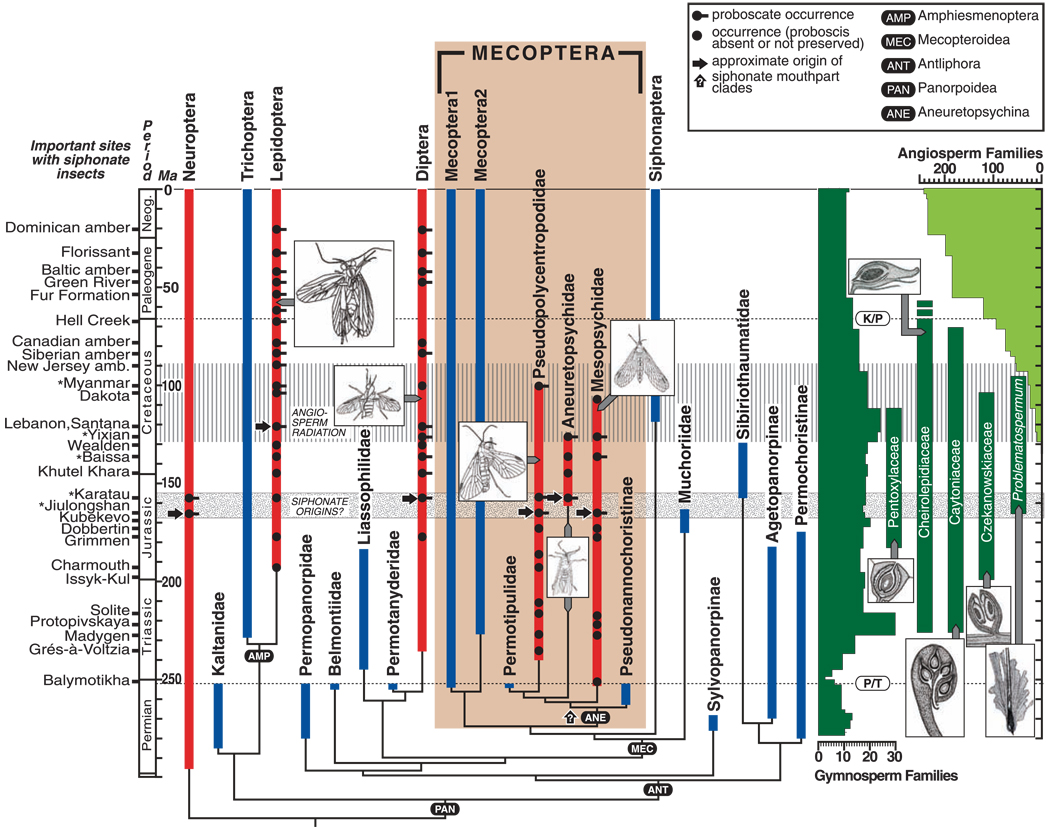Fig. 3.
Major clades of panorpoid insects with siphonate mouthparts and their phylogenetic relationships (center) and likely associations with gymnospermous seed plants (right), presented in geochronologic context (left). At left are geologic periods calibrated to a time scale in millions of years (43); major Mesozoic localities are at the far left; asterisks denote fossil deposits in this report. Major extinction events are the Permian-Triassic (P/T) and Cretaceous-Paleogene (K/P) boundaries, indicated by the plant-insect associational record. At the center are broad, phylogenetic relationships derived from an analysis (13) of a morphology-based character matrix (tables S3 to S5) using a heuristic search in PAUP resulting in one of two best trees, shown here (length = 121, consistency index = 0.521, retention index = 0.725, rescaled consistency index = 0.378, homoplasy index = 0.479, and Goloboff fit criterion = −14.900) (fig. S1). Note the Mesozoic clade of long-proboscid Mecoptera (ANE) basal to remaining Mecoptera. All extant taxa and almost all geochronologically recent, nonsiphonate extinct taxa cluster into Mecoptera 1 ([Robinjohniidae + Bittacidae] + [Nannochoristidae + Boreidae]) and Mecoptera 2 (Panorpidae sensu stricto + [Dinopanorpidae + {Parachoristidae + |Eomeropidae + (Meropeidae + Thaumatomeropidae)|}]) clades. Alternative hypotheses for the origin of long-proboscid Mecoptera are presented as (i) basally within the clade during the Late Permian (bottom arrow with “?”), or (ii) convergently in three constituent lineages during a ~13-My window in the mid-Jurassic, indicated by a stippled horizontal bar. The latter hypothesis is complemented by penecontemporaneous appearances of siphonate proboscides in a neuropteran and multiple brachyceran fly lineages (24), minimally representing five independent origins, indicated by vertical red bars and five accompanying arrows. By contrast, monophyletic siphonate Lepidoptera are delayed, paralleling the ecologic rise of angiosperms. At right are gymnosperm (dark green) and angiosperm (light green) seed-plant diversity patterns (not to the same scale), compiled at conventional family levels (5, 44–50). Dark green vertical bars delineate known ranges of five gymnospermous clades indicated by cross sections of ovulate organs that could represent pollination mutualisms contemporaneous with long-proboscid scorpionflies (table S6). Illustrated are Caytonia sewardi Harris of Caytoniaceae (33, 51, 52), Alvinia bohemica Kvaček of Cheirolepidiaceae (8, 27), Leptostrobus cancer Harris of Czekanowskiaceae (53), Carnoconites compactus Srivastava of Pentoxylaceae (36, 54), and gnetalean Problematospermum ovale Turutanova-Ketova (28, 55). The transverse hatched bar within the Cretaceous (40 My deep) is the global transition from gymnosperm- to angiosperm-dominated floras; the topmost margin indicates the earliest angiosperm’s tubular flowers with nectar (5).

